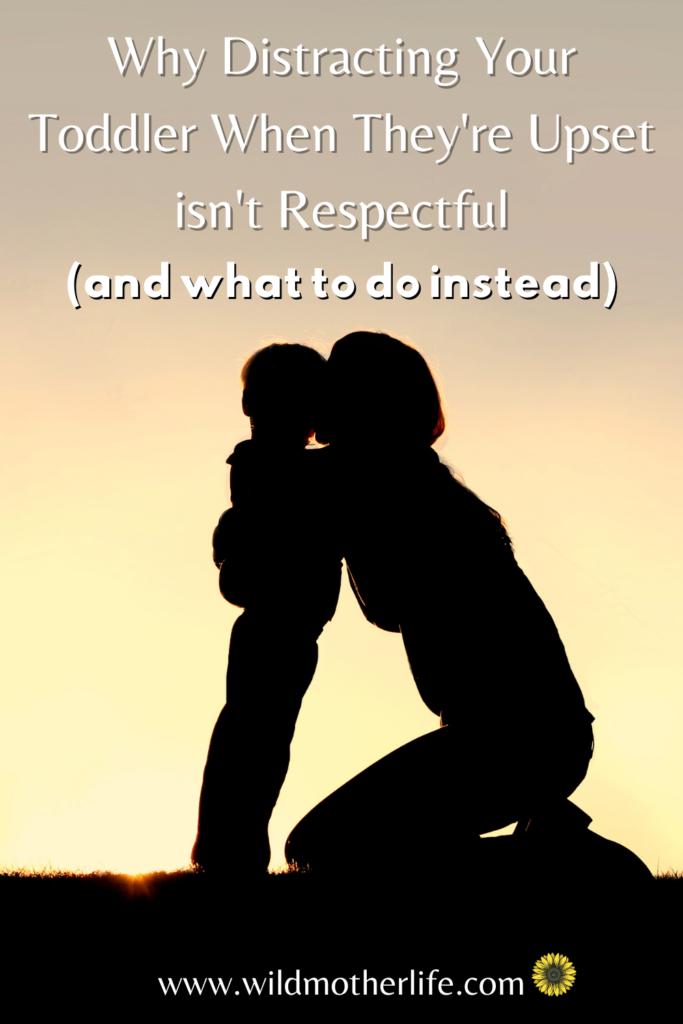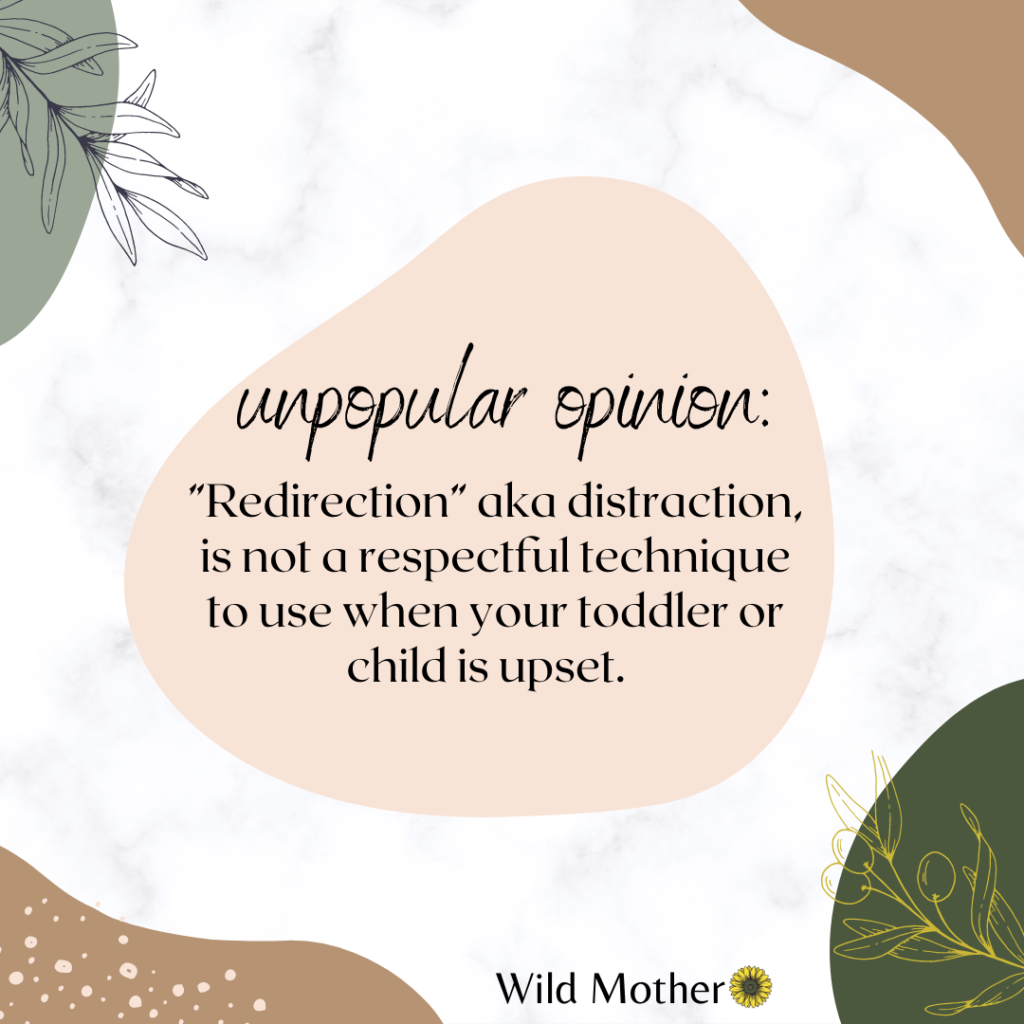
Distracting your Toddler – I see it recommended all the time in gentle parenting groups.
Let’s say a 10-month-old is upset because his mom wouldn’t let him play with something that she deemed dangerous. Mom is asking for advice because the baby is “throwing a tantrum”.
What advice does everyone give?
Redirection. Distraction.
Or maybe a toddler is upset because his mom set a boundary to keep him safe. Mom asks for advice on how to handle his big feelings.
What advice does everyone give?
Redirection. Distraction.
I want to talk about distraction when it comes to handling emotions and why I think it is generally not a respectful way to treat our children.
RELATED: How to Prevent Toddler Tantrums
Why Distracting Your Toddler When They’re Upset Is Not Respectful
1. It teaches them that their emotions make us uncomfortable.
For a lot of us who grew up with parents who did not consider our emotional health when raising us, hearing our children cry DOES make us uncomfortable. It is triggering. It’s why none of us can tear up at something emotional without saying, “oh my goodness, I’m so sorry. I’m trying not to cry.”
The main reason we are uncomfortable with crying is because we were all raised by the generation whose parents believed “children should be seen and not heard”. For many of us, our parents were simply passing down the same teaching they had been raised with; which is why they said “shhhh” to us when we cried as babies, why they would send us to time-out when we threw a tantrum and ground us to our rooms when argued back as we got older.
As kids we learned that when we show emotion or have an outburst, it makes our parents mad at us. They don’t want us around when we’re upset.
We want to do better for our kids. Right?
I’m sure all of the well-meaning parents in the gentle parenting group do not parent the way their parents did. I’m sure they don’t send their toddlers to time out or lock their children in their rooms. However, this triggering feeling that almost all of us get when our child starts crying runs deep within us.
When we give our children another toy or something to distract them immediately after they show disappointment in a boundary, it’s showing them that we are uncomfortable by their emotions, and we will do anything to make them stop crying.
And here’s the thing – we are very attuned and connected to our kids, right? So we WILL DO ANYTHING to help them feel better. To help them stop crying. Simply because we love them and don’t want to see them sad.
But at the root of it, we need to analyze WHY we want to help them stop crying. Why do we view crying as something that needs to be stopped?
Crying is one of the main ways that babies communicate. And children do not have the neurological ability to regulate their emotions when they are young, so in many ways crying is a means of communicating for them too.
Crying should never be ignored, and children should never be left alone to cry. But crying isn’t always a terrible thing that needs to be stopped immediately.
Yes, it pulls on our heartstrings. Yes, it should – because obviously we are always in tune with our children’s cries. As mothers, we hear the needs of our children and we fill those needs.
So when our children cry because of disappointment or a boundary that we placed to keep them safe, don’t treat it any differently. Provide comfort, provide safety to allow them to be disappointed. Let them communicate that. It’s okay.
2. It teaches them to stop feeling sad by distracting themselves with something else.
This one should concern every parent because it’s so easy to see how this affects our day to day life as adults.
Think back to the last time you were feeling super overwhelmed or sad. What did you turn to? If you’ve done growth work as an adult, you may be able to say that you sat with your emotions and allowed yourself to FEEL, maybe journaled, took a warm shower, got extra sleep etc. But let’s face it, there was definitely a time in our lives when we all turned to junk food, chocolate, or wine to drown out our sorrows.
Because when you’re raised to not FEEL your “negative” emotions, you do anything you can to avoid feeling the pain of sadness or uncertainty.
When you’re raised to suppress anything that isn’t happiness and glee, you are conditioned to turn to an outside source for comfort when your emotions are in turmoil.
And for those of us who have not done the work to understand our emotions, that outside source usually involves finding something to numb the pain…even our phones can be used to help us zone out and feel numb.
What to do Instead of Distracting your Toddler
RELATED: What is Intuitive Parenting?
Now I do want to clarify. I’m not saying that you should NEVER start distracting your toddler. I think redirection/distraction can be a tool; a tool that shouldn’t be the first tool we jump to, but a tool to use sparingly sometimes. Like maybe if you’re trying to avoid a meltdown in public or move your child out of an uncomfortable situation before a meltdown ensues, distracting them is fine.
Sometimes I think it’s also fine to use distraction BEFORE your child becomes deep in the situation and becomes upset. Maybe distracting your toddler before they reach the dangerous object or before they start doing something too risky, etc.
But generally speaking, I think we should practice ACCEPTING our children’s emotions and feelings instead of distracting them.
So here’s the advice that I recommend to desperate moms in gentle parenting groups and also how I like to handle this situation in my own life.
Let’s say I set a necessary boundary that my toddler does not like. She gets upset and begins crying, falling on the floor protesting, etc.
Instead of saying, “Aw I know, it’s so hard being little. Don’t be sad! Here, play with THIS toy instead!”
Here is what I recommend doing:
1. Get down on her level.
2. Empathize with her feelings, let her know she is SEEN. “Aw baby I see that you are sad because you really wanted to play with that. It’s not safe so I can’t let you have it. But I’m here for you. I see you’re upset about it. I love you. I’m here.”
3. Model the attitude you want her to have. Calm. Compassion. Empathy. Be the calm anchor for her to cling to when she feels out of control.
4. Ask “do you want to take a deep breath together?” “Do you need a hug?” “How can I help?”
Generally following these principles when your child protests a boundary is the perfect balance of connection and leadership. We recognize their feelings, genuinely empathize with them, allow them to feel however they want to feel about it, but we also stand firm in the boundary. Because we have to keep them safe.
These emotional outbursts can last for thirty seconds, or sometimes thirty minutes. But I’ve found it’s long-term more respectful to my child to ride the wave of their emotions with them, instead of trying to come up with a short-term “quick fix” to make them stop crying.
RELATED: Nature Walk Activities for Toddlers
Click to read another great article on this topic
And I just want to say – I know we all have hard days. I know there are days when we are so tired we feel like we cannot possibly help our child through *another* tantrum.
Always give yourself grace. Children are so resilient and forgiving, and our kids love us so much. Always remember that you are doing an amazing job raising your little ones.



